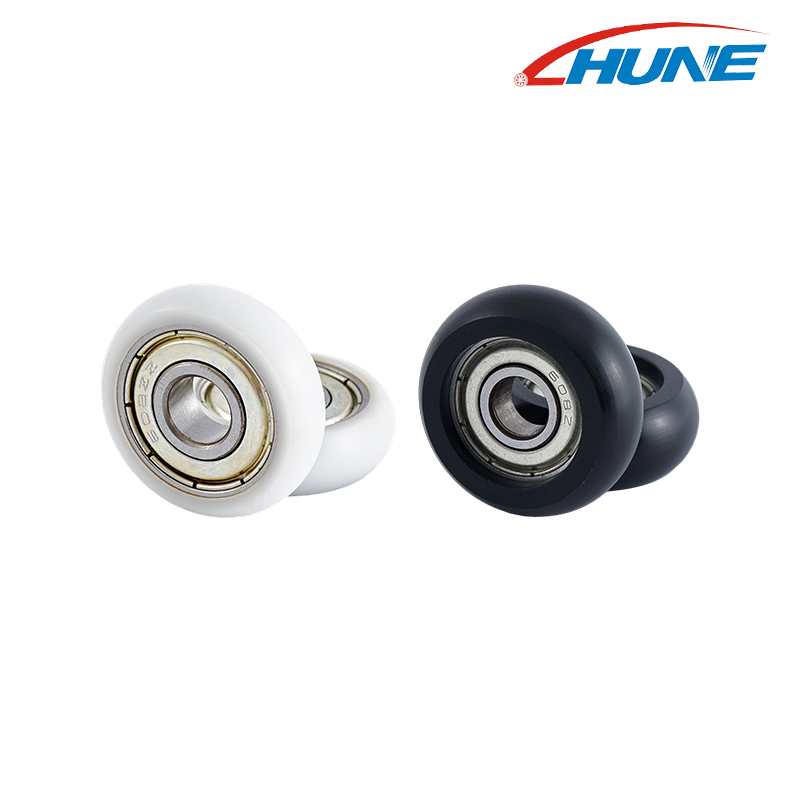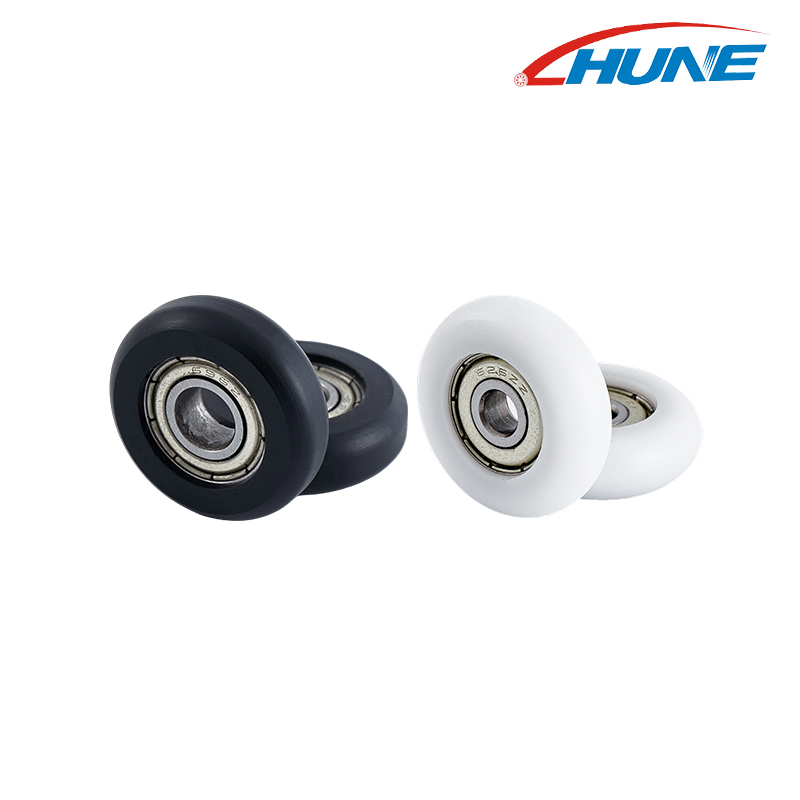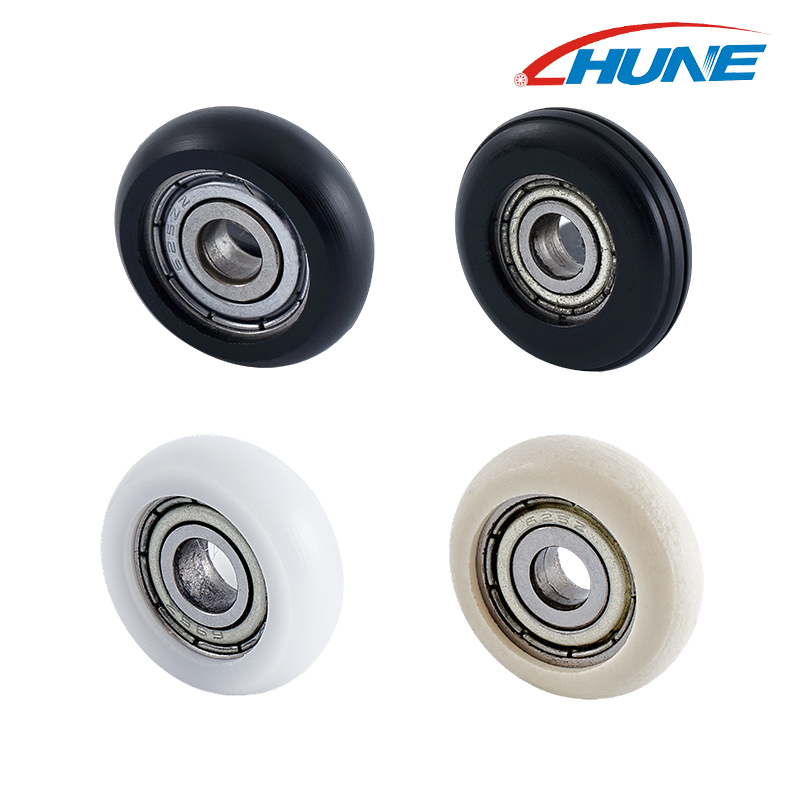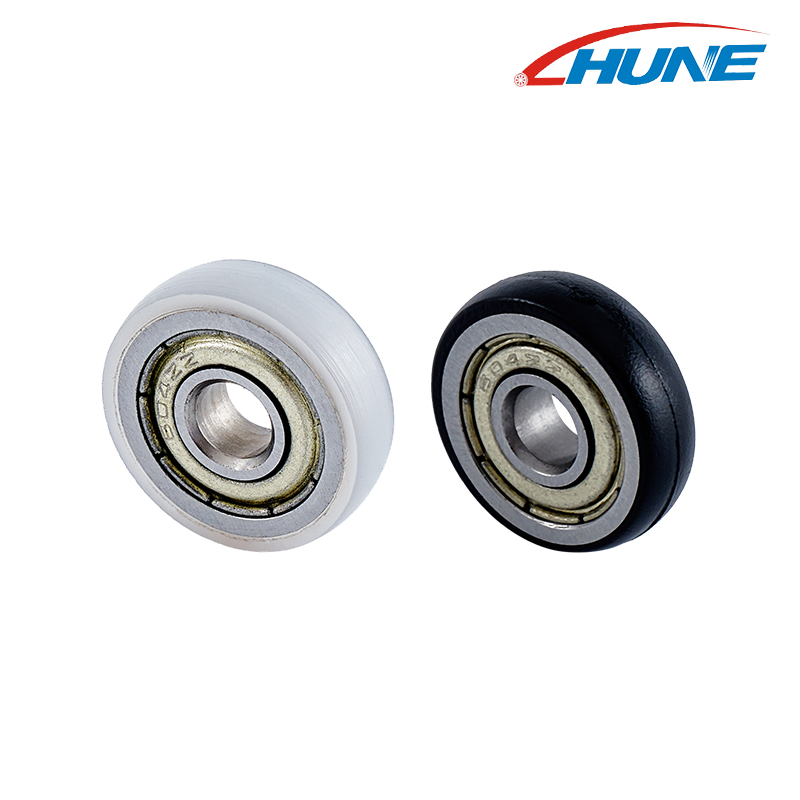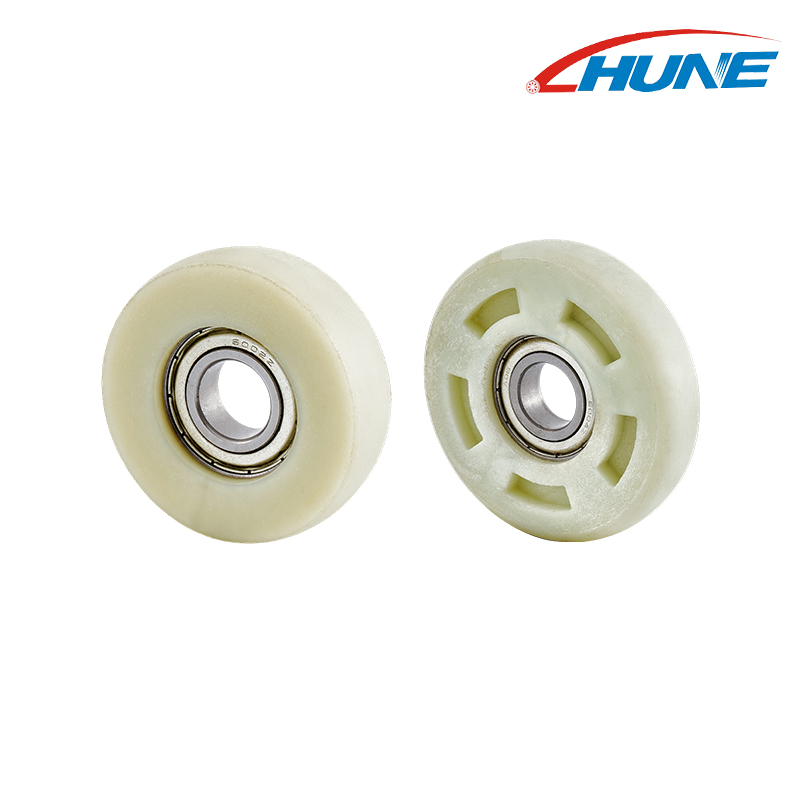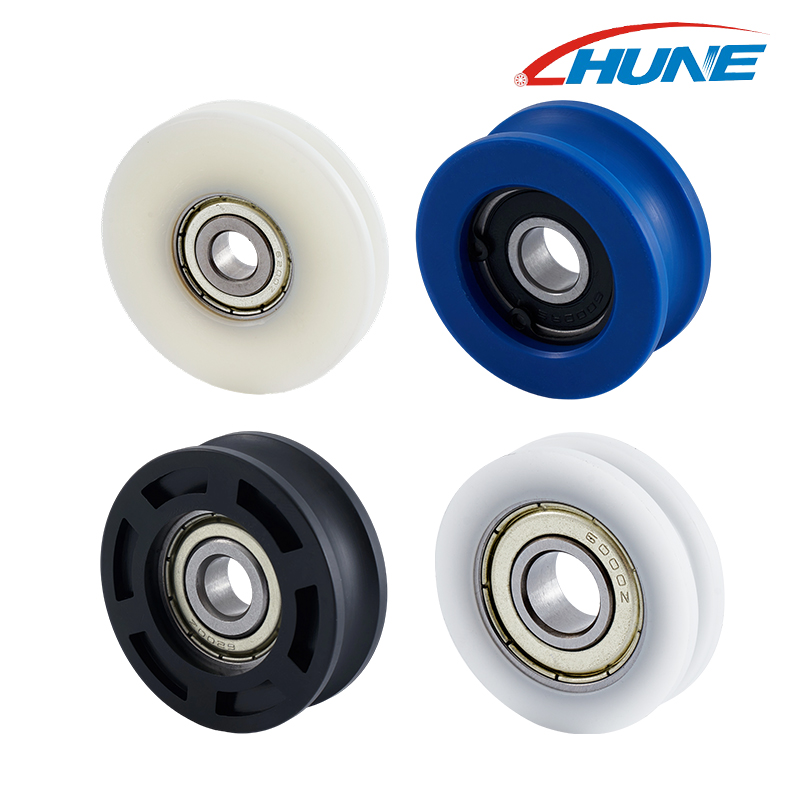1. What Is a Screw Thread Bearing Pulley and How Does It Work?
Definition and Basic Composition
A Screw Thread Bearing Pulley is a highly specialized mechanical component designed to perform multiple mechanical functions simultaneously. It merges three distinct mechanical systems—threaded screw mechanisms, rotational pulleys, and bearing assemblies—into a compact and efficient form. These pulleys are commonly used in linear motion systems, precision positioning devices, and automated machinery where accurate and stable motion control is essential.
At its core, the screw thread bearing pulley serves three main purposes:
Threaded Screw Functionality – Converts rotary motion into linear displacement through mechanical threading.
Pulley Transmission – Engages with belts or cables to transmit force or motion across a mechanical system.
Bearing Support – Reduces friction, stabilizes movement, and ensures smooth rotational or axial performance.
The integration of these elements allows for advanced mechanical operations within limited space, making the screw thread bearing pulley a favored solution in modern engineering design.
Fundamental Mechanical Roles
Understanding how this component functions requires breaking down its internal roles:
The screw thread provides axial movement by engaging with a nut or moving carriage.
The pulley facilitates belt or cable drive, commonly used to move objects or actuators.
The bearing supports and stabilizes motion, either rotational or linear, depending on the configuration.
This multifaceted design allows engineers to simplify mechanical systems, reduce the need for separate components, and improve mechanical synchronization.
Core Components Explained
1. Threaded Shaft or Body
The threaded shaft is the heart of the component. It is either an internal or external thread cut along the axis of the pulley, often machined to exact specifications using precision lathes or thread milling machines.
Lead and Pitch:
The thread lead determines how far a connected nut or carriage travels in one rotation. Higher leads result in faster motion but lower mechanical advantage.
Thread Profiles:
Depending on the requirement, profiles like Acme, trapezoidal, or ball screw threads are used. Acme threads are stronger but less efficient; ball screw threads are high-performance but require ball nut assemblies.
Applications:
In automation, threaded motion is used to move platforms or tools precisely along an axis.
2. Pulley Groove or Channel
The outer edge of the component typically includes a pulley groove, which interfaces with a belt or cable. These grooves are carefully machined or molded to ensure proper belt tracking and power transfer.
Groove Profiles:
V-groove: Used with V-belts in high-torque applications.
U-groove: Suited for round belts or wire cables.
Flat pulley: Designed for friction drive or flat belts.
Multi-Groove Configurations:
Some designs may feature multiple grooves for multiple belts, improving torque distribution and redundancy.
3. Bearing Assembly
Located within or behind the pulley structure is a bearing—usually a ball bearing, roller bearing, or angular contact bearing.
Bearing Purpose:
Supports the rotational load.
Reduces friction between the rotating pulley and the stationary mount or shaft.
Enhances system longevity and efficiency.
Bearing Types Used:
Single-row ball bearings: Common for light to moderate loads.
Double-row or angular contact bearings: Used when axial loads or misalignment forces are significant.
4. Mounting and Integration
How the screw thread bearing pulley is mounted determines its performance and stability.
Mounting Methods:
Set screws: Secure the pulley to a shaft.
Keyways: Transmit torque more reliably and prevent slippage.
Flanges: For face-mounted configurations on frames or assemblies.
Housing Compatibility:
In many designs, the pulley is housed inside a block or rail system, especially in CNC machines or linear modules.
Working Principle
The screw thread bearing pulley performs complex motion tasks by combining rotary input with linear output, while simultaneously managing mechanical loads. Let’s examine each function.
Rotational to Linear Motion Conversion
When the pulley is rotated (often via a belt-driven motor), the threaded shaft inside begins to convert this rotation into linear motion:
If a nut or carriage is threaded onto the shaft, it will move axially as the shaft turns.
This is governed by the thread lead; higher leads move faster but with less force.
This principle is similar to that of a lead screw system, but with a built-in pulley and bearing.
This mechanism is foundational to linear actuators, Z-axis movement in 3D printers, and automated stage controllers.
Load Bearing and Transfer
With the bearing integration, the system can:
Sustain radial and axial loads from attached components.
Rotate smoothly without producing excessive heat or vibration.
Withstand repetitive stress and motion cycles.
Belt Drive Synchronization
The pulley groove allows the system to synchronize with belts or timing drives. This enables coordination with other machine components or axis systems. For example:
In a multi-axis CNC system, one pulley might control vertical positioning while others handle lateral motion.
In laboratory automation, belts driven by motors rotate the pulley to move dispensers, sensors, or trays.
Advantages of Combined Design
The screw thread bearing pulley design is compact, efficient, and versatile. Key benefits include:
Space Efficiency: Instead of separate pulley, screw, and bearing parts, one integrated unit is used.
Improved Precision: Fewer parts mean fewer alignment issues.
Enhanced Load Capacity: Bearings support both axial and radial forces.
Low Friction Motion: Thanks to the bearing, rotational drag is minimized, which improves power efficiency.
Lower Maintenance: Integrated components reduce complexity, allowing for simpler servicing schedules.
Material and Manufacturing Considerations
The choice of materials and the manufacturing process greatly influence the pulley’s performance, life cycle, and cost.
Common Materials
Steel (e.g., 1045 or 4140):
Ideal for heavy-duty industrial use where strength and wear resistance are critical.
Stainless Steel (e.g., 304, 316):
Used in corrosive environments such as marine, chemical, or food processing applications.
Aluminum:
Lightweight, corrosion-resistant, suitable for compact equipment or low-load scenarios.
Engineering Polymers (e.g., POM, Nylon):
Cost-effective and quiet; useful in low-friction, low-load environments like small consumer electronics or optical devices.
Surface Treatments and Finishing
Anodizing (for aluminum): Improves corrosion resistance and wear.
Zinc or nickel plating (for steel): Adds a protective layer to prevent rust.
Black oxide (for carbon steel): Reduces glare and provides mild corrosion resistance.
Precision Machining Techniques
Thread Cutting:
Done on CNC lathes or precision mills, depending on the thread profile and material.
Groove Machining:
Requires careful control to ensure depth and pitch match the belt design.
Bearing Seat Tolerance:
Must be within micrometer range to ensure a snug, aligned fit for bearing installation.
Variations and Hybrid Designs
Modern engineering has given rise to several variations of screw thread bearing pulleys, such as:
Flanged Pulleys with Integrated Screws – Allow for bolted assembly and modular use.
Hollow-Core Pulleys – For weight savings or cable pass-through.
Anti-Backlash Pulleys – Use special threads or springs to eliminate play.
Encoder-Integrated Designs – For motion feedback in automation systems.
A screw thread bearing pulley is a multi-functional, precision mechanical part designed to convert rotational energy into linear motion, transmit power via belts, and support mechanical loads via integrated bearings. Its ability to unify these distinct mechanical roles into a single, compact component makes it essential in advanced machinery.
From CNC tools and robotics to laboratory instruments and optical systems, the versatility and precision offered by this component enable innovations in motion control and mechanical efficiency. Understanding how it works—both in theory and in application—is crucial for engineers, designers, and technicians working across modern industries.
2. Where and Why Are Screw Thread Bearing Pulleys Used?
Industrial Automation and Robotics
One of the most prominent fields where screw thread bearing pulleys excel is industrial automation and robotics. Automation systems often require precise, repeatable linear movements combined with rotational inputs from motors or drives, making these pulleys a perfect fit.
Precision Positioning in CNC Machines
Computer Numerical Control (CNC) machines rely heavily on accurate linear motion to create complex shapes and parts. The screw thread bearing pulley enables:
Smooth Z-axis motion:
For vertical movements of the cutting tool or workpiece, the pulley converts rotary motor action into controlled vertical travel.
Load handling:
The bearing supports the toolhead or platform weight, ensuring minimal vibration and precise cutting.
Compact design:
CNC machines often have limited space; integrating screw threads with pulleys saves valuable real estate.
Robotic Arms and Automated Pick-and-Place Systems
Robotic manipulators demand fine control over linear and angular motions. These pulleys help to:
Synchronize joint movements:
By translating motor rotations into linear displacement of arms or grippers.
Improve repeatability:
The threaded system minimizes backlash, crucial for delicate assembly or packaging tasks.
Handle dynamic loads:
Bearings absorb sudden forces when the robot picks or places objects, protecting the motor and structural elements.
3D Printing and Additive Manufacturing
In 3D printers, especially in the Z-axis or gantry movement, screw thread bearing pulleys ensure:
Precise layer-by-layer movement:
Leading to higher print resolution and surface finish.
Silent operation:
Bearings reduce noise, improving the user experience in home or office environments.
Long service life:
Reduced wear translates into less frequent maintenance and calibration.
Elevator and Conveyor Systems
Another major area of application is material handling, particularly in elevator mechanisms and belt conveyor systems, where reliable load transfer and controlled movement are essential.
Miniature Lifting and Positioning
In smaller scale elevators such as those used in laboratories or compact storage units:
Stable linear lifting:
Screw thread bearing pulleys provide a smooth vertical travel path with minimal vibration.
Load distribution:
Bearings reduce stress on structural supports by evenly managing forces during lifting.
Precision positioning:
Critical when aligning platforms or trays for robotic or manual access.
Belt Tensioning in Conveyor Lines
In belt-driven conveyors used in factories and packaging:
Maintaining proper belt tension:
Screw thread bearing pulleys act as tensioners, adjusting belt tightness to prevent slippage.
Absorbing shock loads:
Bearings help dampen sudden jerks from start-stop cycles, extending belt life.
Compact, adjustable designs:
The threaded shaft allows easy adjustment of pulley position, simplifying maintenance.
Compact Elevator Drives
Small-scale or service elevators benefit from:
Threaded motion for safety:
Self-locking screw threads prevent accidental descent in power failure.
Smooth load transitions:
Bearings facilitate quiet and smooth door or platform movement.
Medical and Laboratory Equipment
Precision and reliability are paramount in medical devices and laboratory instruments. The screw thread bearing pulley finds specialized uses here due to its fine motion control and quiet operation.
Surgical Robotics
Surgical robots require:
Micron-level precision:
The combination of thread pitch control and bearing smoothness enables surgeons to manipulate instruments accurately.
Reliable load bearing:
Supporting the weight of surgical tools and robotic arms without play.
Sterile operation:
Stainless steel or coated materials resist corrosion and are easy to clean.
Adjustable Scanning and Imaging Tables
In medical imaging (e.g., MRI, CT), the patient table must move precisely and quietly:
Threaded linear motion:
Allows fine adjustments in height and position during scanning.
Smooth, backlash-free operation:
Ensures image clarity and patient comfort.
Load capacity:
Supports heavy patient weights safely and reliably.
Microscopy Stages
In microscopes used in research and clinical labs:
Fine axial adjustment:
Screw thread bearing pulleys control the focus mechanism with extreme precision.
Noise reduction:
Bearings minimize operational noise, important in sensitive environments.
Durability:
Materials and design resist wear from constant, repetitive use.
Optoelectronics and Precision Instruments
Devices such as telescopes, cameras, and optical scanners rely on smooth, stable motion for focus and positioning.
Telescope Focusing Systems
Astronomical telescopes often use screw thread bearing pulleys to:
Precisely move optical elements:
Allowing astronomers to focus on distant objects with minimal backlash.
Support heavy lenses or mirrors:
Bearings handle weight without binding.
Provide long-term reliability:
Operating in outdoor or variable temperature conditions.
Camera Zoom and Focus Mechanisms
High-end cameras and lenses integrate these pulleys to:
Achieve smooth zooming:
Threaded shafts convert rotary dials into smooth lens movement.
Enhance durability:
Bearings reduce wear and extend product life.
Allow compact design:
Combining pulley and screw functions saves space inside the lens barrel.
Scanning Devices and Optical Readers
In barcode readers or laser scanners:
Controlled linear positioning:
Essential for scanning accuracy.
Noise reduction:
Bearings reduce vibration-induced errors.
Why These Applications Rely on Screw Thread Bearing Pulleys
Across all these industries, the reasons for using screw thread bearing pulleys stem from their unique mechanical advantages:
1. Precision and Repeatability
The combination of screw threads with bearings reduces backlash and play, delivering consistent positioning essential for manufacturing, medical, or optical devices.
2. Load Capacity and Stability
Bearings enable the pulley to handle both axial and radial loads, critical in heavy-duty industrial applications or sensitive medical instruments.
3. Space and Weight Efficiency
Integrating three mechanical functions into one component reduces the size and weight of assemblies, beneficial in compact machines, robotic arms, or portable devices.
4. Low Noise and Smooth Operation
The bearing assembly minimizes friction and vibration, making these pulleys suitable for quiet environments like hospitals or laboratories.
Future Trends in Application
The expanding fields of automation, robotics, and precision medical devices will continue to drive innovation in screw thread bearing pulley design. Trends include:
Smart Pulleys:
Integration with sensors for real-time position and load monitoring.
Advanced Materials:
Use of ceramics or composites for lighter weight and higher corrosion resistance.
Modular Systems:
Pulleys designed for quick interchangeability to reduce machine downtime.
Miniaturization:
Smaller, more precise pulleys for micro-robotics and nano-positioning.
Screw thread bearing pulleys are essential mechanical components in a diverse range of modern industries. Their ability to combine precision motion control, reliable load handling, and efficient power transmission makes them irreplaceable in automation, material handling, medical devices, and optoelectronics.
Understanding where and why these pulleys are used helps engineers and technicians appreciate their value and select the right types for their specific needs, ensuring optimal system performance and longevity.
3. What Are the Key Types and Variations of Screw Thread Bearing Pulleys?
Screw thread bearing pulleys are designed to meet a wide range of mechanical demands, and their diversity arises from variations in thread design, bearing configuration, and pulley groove styles. Understanding these types and variations is critical for selecting the appropriate pulley for specific applications. This section delves into the primary categories of screw thread bearing pulleys, exploring their unique characteristics, advantages, and typical use cases.
Thread Types and Their Impact on Performance
The threaded portion of the pulley fundamentally defines how rotary motion translates into linear motion, and different thread profiles serve distinct purposes. The most common thread types include Acme, trapezoidal, ball screw threads, and lead screws.
Acme Threads are one of the earliest and most widely used profiles. Their trapezoidal shape offers strength and ease of manufacture, making them suitable for medium-precision applications where durability outweighs the need for ultra-fine accuracy. Acme threads are commonly found in machinery where moderate thrust loads and relatively low speeds are expected. Their broad thread profile allows for easier cleaning and maintenance, which is advantageous in environments prone to dust or debris.
Trapezoidal Threads, similar in profile to Acme but standardized in metric and imperial forms, are highly popular in Europe and many industrial sectors worldwide. These threads strike a good balance between strength, wear resistance, and efficiency. They provide smooth, reliable operation with moderate backlash, which makes them suitable for applications like machine tools, linear actuators, and medium-duty conveyors.
Ball Screw Threads represent a leap in performance, designed for high-efficiency and precision applications. Unlike traditional threads, ball screw threads use recirculating ball bearings between the threaded shaft and nut, significantly reducing friction and wear. This design delivers near 100% mechanical efficiency, enabling smooth, accurate linear motion even under high-speed or high-load conditions. Ball screw pulleys are preferred in CNC machines, robotics, and aerospace mechanisms where positioning accuracy and minimal backlash are paramount.
Lead Screws are another important category, characterized by a simpler thread form optimized for self-locking under load. While less efficient than ball screws, lead screws provide safety advantages in applications requiring holding torque without continuous power, such as lifting platforms or clamps. Their ease of manufacture and ability to maintain position without power make them common in medical devices and small lifting systems.
Bearing Configurations and Their Influence on Durability and Precision
The bearing assembly within a screw thread bearing pulley is critical for minimizing friction and supporting radial and axial loads. Different bearing configurations affect the pulley’s load capacity, speed capability, and operational lifespan.
Single Bearing Pulleys feature a basic bearing setup, usually a single row of ball or roller bearings. This design is straightforward and cost-effective, ideal for low to moderate speed and load conditions. It suits lightweight machinery or applications where space is limited and the load demands are not extreme.
Double Bearing Pulleys incorporate two sets of bearings, often arranged back-to-back or face-to-face. This setup enhances the pulley’s ability to handle both radial and axial loads, providing greater stability and durability. Double bearing pulleys are preferred in heavy-duty conveyors, industrial machinery, and robotic systems subjected to multi-directional forces. Their improved rigidity also reduces vibration and extends component lifespan.
Angular Contact Bearings are specialized bearings designed to tolerate combined radial and axial loads, especially when forces are applied at an angle. Integrating angular contact bearings into screw thread pulleys allows them to maintain precise alignment under complex loading conditions. These pulleys excel in high-speed spindles, precision medical instruments, and aerospace actuators where even minimal misalignment can cause critical errors or premature wear.
Pulley Groove Styles and Their Functional Roles
The groove profile on the pulley surface governs how belts, cables, or ropes engage with the pulley, directly affecting transmission efficiency, wear patterns, and compatibility with various drive systems.
V-Groove Pulleys are the most traditional and widespread style. Their V-shaped channel is optimized for V-belts, which wedge into the groove to increase friction and prevent slipping. This configuration offers reliable power transmission with relatively simple design and maintenance. V-groove pulleys are common in automotive engines, agricultural equipment, and industrial power drives.
Round or U-Groove Pulleys feature a semi-circular or U-shaped channel designed to accommodate round belts or cables. This groove style is typical in cable-driven systems or applications where the belt must wrap securely around the pulley without sharp bending. These pulleys often appear in lifting equipment, cable transport systems, and some types of conveyor lines where smooth belt engagement is necessary.
Flat Pulleys have a flat surface instead of a groove and are used with flat belts or friction-based systems. Although flat belts are less common today, they still have advantages in certain lightweight or high-speed transmissions due to reduced bending stress on the belt. Flat pulleys are often used in textile machinery, paper processing, or older mechanical systems that require minimal belt wear.
Customization and Specialized Variations
Beyond standard types, screw thread bearing pulleys can be highly customized to meet niche requirements. Customization may involve changes to material, surface treatments, thread pitch, or integration of additional features.
Material Selection plays a vital role in pulley performance. Steel and stainless steel are favored for their strength and wear resistance, particularly in heavy-duty or corrosive environments. Aluminum pulleys provide a lightweight alternative for applications where mass reduction is important, such as aerospace or portable machinery. Polymers and composite materials may be used in low-load, noise-sensitive settings where lubrication is difficult or cleanliness is critical.
Surface Coatings enhance durability and resistance to corrosion or wear. Common coatings include zinc plating, nickel plating, or hard anodizing for aluminum pulleys. In high-wear or chemically aggressive environments, specialized coatings like PTFE or ceramic may be applied to reduce friction and extend service life.
Thread Pitch and Lead determine how far the pulley moves linearly with each rotation. Fine pitch threads offer high precision and smooth motion but typically lower speed and thrust capacity. Coarser pitches allow faster linear travel and greater thrust but sacrifice some positional accuracy. Selecting the appropriate thread lead is crucial for balancing speed, load, and precision in the target application.
Integrated Features such as locking rings, keyways, or encoder slots can be added to screw thread bearing pulleys to improve mounting security, torque transmission, or position feedback. These features simplify installation and integration into complex automated systems.
In summary, the variety of screw thread bearing pulleys available reflects the wide spectrum of engineering challenges they address. From the robust Acme threads suited to general mechanical tasks, to the highly precise ball screw designs favored in advanced automation, each type serves distinct functional niches. Bearing configurations further tailor pulleys to handle specific load and speed demands, while groove profiles ensure compatibility with various belt and cable systems.
Customization options empower engineers to optimize pulleys for their unique operating environments, balancing cost, durability, precision, and maintenance needs. A thorough understanding of these types and variations enables informed decision-making, ensuring that the right screw thread bearing pulley is selected for each application’s technical requirements and operational constraints.
4. How to Select the Right Screw Thread Bearing Pulley for Your Application
Choosing the appropriate screw thread bearing pulley for a particular application involves careful consideration of various factors. This process is crucial to ensure the component functions reliably, efficiently, and lasts as long as possible. Selecting incorrectly can lead to premature wear, system failure, or costly downtime. This section guides through the key aspects to evaluate when making this important choice.
Understanding the Motion Requirements
The foremost step is to clearly define the motion characteristics your system demands. Screw thread bearing pulleys convert rotary motion into linear motion, but the details vary widely based on design.
You need to determine the exact nature of the linear movement required. For example, what is the desired travel distance per rotation? This depends on the thread lead or pitch—the distance the pulley advances axially with each full turn. A fine pitch will yield high precision and smooth motion, ideal for positioning tasks requiring minute adjustments, like in optical instruments or CNC machines. Conversely, a coarser pitch suits applications needing faster movement over longer distances, such as conveyor adjustments or lift mechanisms.
The direction and frequency of motion are also important. Some applications involve continuous back-and-forth movement, while others require one-way travel or intermittent actuation. Understanding the duty cycle helps determine the pulley’s durability requirements and bearing type.
Assessing Load Conditions
Load analysis is vital because screw thread bearing pulleys must withstand forces acting both along and perpendicular to the shaft.
Axial load, the force along the screw’s axis, often arises from the object being moved or the tension in the belt or cable. The pulley and its bearing must be designed to support this load without excessive wear or deformation.
Radial load acts perpendicular to the shaft and comes from belt tension or external forces. Pulley bearings must handle these loads while maintaining smooth rotation. If the system experiences moment loads—torques or bending forces due to off-center weights or misalignment—the pulley must have robust bearing arrangements like double or angular contact bearings to resist damage.
Ignoring load details can result in bearing failure, thread stripping, or belt slippage. Therefore, it’s essential to calculate or estimate expected loads accurately and select pulleys rated to exceed those values with a safe margin.
Speed and Precision Considerations
The operating speed of the pulley significantly influences material and bearing choices.
High-speed applications demand pulleys with excellent dynamic balance to minimize vibration and noise. Bearings must be capable of high revolutions per minute (RPM) without overheating or premature wear. In such cases, ball screw bearing pulleys with preloaded bearings and high-quality lubrication are ideal.
Precision requirements vary greatly depending on application. Tasks such as robotics, optical equipment, or semiconductor manufacturing require minimal backlash—the lost motion or looseness in the thread mechanism. Ball screw types typically provide the best precision due to their rolling contact and tight manufacturing tolerances.
In contrast, simpler trapezoidal or Acme threads might suffice for less demanding applications like industrial conveyors or manual adjustments where minor backlash is tolerable.
Environmental Factors and Material Choices
The environment in which the pulley operates heavily influences material selection and design features.
For outdoor or corrosive environments, stainless steel pulleys are preferred due to their corrosion resistance. Zinc or nickel plating may be added for extra protection. In dusty, dirty, or abrasive surroundings, sealed or shielded bearings prevent contaminants from causing premature wear.
Temperature extremes require special consideration. High temperatures may degrade lubrication or polymer components, necessitating heat-resistant materials or specialty lubricants. Similarly, cryogenic or ultra-clean environments—like semiconductor fabrication—require materials that do not outgas or generate particulates.
Noise sensitivity is another factor. Plastic or composite pulleys reduce operating noise and are useful in medical or office equipment where quiet operation is valued.
Mounting and Compatibility
It is essential to verify that the chosen pulley fits well with the existing system.
The bore diameter—the hole through which the pulley shaft passes—must match the shaft size precisely. Mounting holes, keyways, and set screw locations must align with the equipment’s hardware. Thread direction (right-hand or left-hand) and lead must be compatible with the intended motion and mating components like nuts or carriages.
Checking belt or cable compatibility with the pulley groove profile prevents slipping and premature wear. Using the correct belt type and maintaining appropriate tension is equally important.
Ease of installation and removal may influence design choices. Some pulleys are designed for quick disassembly, while others may require pressing or special tools. Consider the maintenance capabilities and resources available.
Maintenance and Longevity Considerations
Selecting a pulley that facilitates maintenance can save time and money.
Some designs incorporate sealed bearings requiring minimal lubrication, which reduces downtime. Others may have lubrication ports for regular servicing. Easy access to bearings and threads simplifies inspection and cleaning.
Predicting the expected lifespan based on duty cycle, loads, and environmental stresses helps in choosing pulleys with suitable durability. High-quality bearings and corrosion-resistant materials typically extend service life.
Planning for spare parts availability and compatibility with replacements is also critical. Using standardized pulleys or modular designs can ease future upgrades or repairs.
Practical Tips for Decision Making
Before finalizing a choice, gather as much data as possible about your application, including motion profiles, load measurements, environmental conditions, and existing system constraints.
Consult manufacturer catalogs and technical datasheets for specifications such as load ratings, permissible speeds, and material properties. Where possible, work with suppliers to obtain custom solutions if standard options do not fit.
If precision is paramount, consider prototypes or sample testing to validate pulley performance under real-world conditions. Monitoring initial operation can reveal unexpected issues like misalignment or premature wear, allowing adjustments before full deployment.
In conclusion, selecting the right screw thread bearing pulley is a multi-faceted decision that integrates motion requirements, load conditions, speed, environment, compatibility, and maintenance considerations. Balancing these factors leads to optimal performance, reliability, and cost-effectiveness. Taking a systematic approach and leveraging technical resources ensures that the chosen pulley will meet the demands of your application both now and in the future.
5. Common Challenges and Maintenance Tips for Screw Thread Bearing Pulleys
Screw thread bearing pulleys are vital components in many mechanical systems, but like all machinery parts, they face various challenges during operation. Understanding these common issues and following effective maintenance practices can significantly extend the service life of the pulley and prevent costly downtime.
Misalignment Issues
One of the most frequent problems encountered with screw thread bearing pulleys is misalignment. When the pulley shaft or mounting surface is not perfectly aligned with the mating components, uneven stresses develop on the belt and bearings. This can cause abnormal wear patterns on the pulley groove and belt surface, leading to premature failure.
Misalignment often manifests as vibration, unusual noise, or wobbling during operation. It can also accelerate bearing fatigue by creating uneven load distribution. To avoid this, precise installation procedures should be followed. Using alignment tools such as dial indicators or laser alignment devices helps ensure that the pulley is mounted true to the shaft and parallel to the belt path.
Regular inspections can detect early signs of misalignment before severe damage occurs. If misalignment is suspected, rechecking mounting tolerances and correcting installation errors is crucial.
Thread Wear and Jamming
The threaded section of the pulley is essential for translating rotational movement into linear displacement. However, this thread is susceptible to wear and contamination over time. Dirt, dust, and debris can accumulate in the threads, causing increased friction and potential binding.
Lack of lubrication or using inappropriate lubricants may also accelerate thread wear or lead to corrosion. This results in rough movement, reduced accuracy, and possible jamming of the pulley mechanism.
To mitigate these issues, regular cleaning of the threaded area is recommended. Using dry-film lubricants or greases compatible with the pulley’s material helps maintain smooth operation. In harsh environments, protective covers or seals can prevent contaminants from reaching the thread.
Periodic functional checks to ensure the pulley moves freely along its axis without resistance are beneficial. If wear is excessive, replacement of the pulley or thread components may be necessary.
Bearing Fatigue and Failure
Bearings are critical to the pulley’s smooth rotation and load distribution. Over time, bearings can suffer fatigue due to cyclic stresses, contamination, or insufficient lubrication. Bearing failure often shows as increased noise, excessive play, or higher operating temperatures.
High-load or high-speed applications are especially prone to bearing issues. Using high-quality bearings designed for the specific load and speed conditions of the application is important. Sealed bearings help keep dirt and moisture out, extending bearing life.
Regular maintenance should include checking bearing condition through vibration analysis or temperature monitoring if possible. When signs of bearing degradation appear, timely replacement prevents damage to other pulley parts.
Belt Slippage and Groove Damage
Belt slippage reduces transmission efficiency and can damage both the belt and pulley groove. Incorrect belt tension, mismatched belt profile, or worn grooves are common causes.
Over-tensioning the belt may deform the pulley groove, altering its profile and compromising belt fit. Conversely, under-tensioning leads to slippage and heat buildup.
Using a belt tension gauge ensures the belt is properly tensioned. Selecting the correct belt type that matches the pulley groove—whether V-belt, flat belt, or round cable—is essential. Regular inspection of groove wear and replacement of worn pulleys help maintain system integrity.
Maintenance Practices for Longevity
Effective maintenance extends the operational life of screw thread bearing pulleys and improves system reliability.
Visual Inspections: Frequent checks for cracks, corrosion, or wear help detect issues early. Look for signs of deformation in the groove and cleanliness around the threads.
Lubrication: Follow manufacturer recommendations on lubrication intervals and types. Avoid over-lubrication, which can attract contaminants.
Fastener Tightness: Ensure all mounting screws and bolts remain tight to prevent loosening due to vibration.
Bearing Care: Replace bearings at scheduled intervals or if symptoms of wear appear. Use compatible replacement parts.
Cleaning: Keep threads and grooves free of debris. Employ protective covers if operating in dirty environments.
In summary, the screw thread bearing pulley’s performance depends not only on correct selection and installation but also on vigilant maintenance and early detection of common problems. Addressing misalignment, thread wear, bearing fatigue, and belt slippage proactively will minimize downtime and repair costs, ensuring smooth and accurate mechanical motion for years.
Conclusion
Screw thread bearing pulleys are indispensable components that combine the unique capabilities of threads, bearings, and pulleys into one efficient mechanical unit. Their ability to convert rotary motion into precise linear movement, while supporting substantial loads smoothly, makes them fundamental in a wide range of modern applications—from industrial automation and robotics to medical equipment and optical devices.
Throughout this article, we explored the fundamental structure and working principles of these pulleys, highlighting their hybrid design that seamlessly integrates screw threads for motion translation, bearings for friction reduction, and grooves for belt or cable guidance. Understanding these core features is vital to appreciating how such a compact component can deliver complex motion control reliably.
We also examined the diverse fields where screw thread bearing pulleys excel, emphasizing their contribution to precision, durability, and smooth operation in environments requiring fine positioning and heavy load support. Their adaptability across different industries underscores their importance in today’s technologically advanced machinery.
Choosing the right pulley involves a careful balance of motion requirements, load capacities, speed needs, environmental considerations, and compatibility with existing systems. Proper selection ensures that the pulley meets performance expectations, minimizes maintenance, and prolongs system life. This decision-making process is crucial to avoid premature failures and costly downtime.
Moreover, recognizing common challenges such as misalignment, thread wear, bearing fatigue, and belt issues, and applying sound maintenance practices, significantly enhances operational reliability. Regular inspection, cleaning, lubrication, and timely bearing replacement are key to preserving the pulley’s performance over time.
As machinery and automation technologies continue to evolve, innovations in materials, bearing designs, and thread manufacturing will further improve the capabilities and applications of screw thread bearing pulleys. Staying informed about these advances enables engineers and technicians to implement the most effective solutions for their specific mechanical needs.
In essence, the screw thread bearing pulley is a prime example of elegant mechanical engineering—combining precision, strength, and versatility in a compact form. Its ongoing relevance across numerous industries testifies to its value as a critical mechanical component, driving the performance and accuracy of countless machines worldwide.
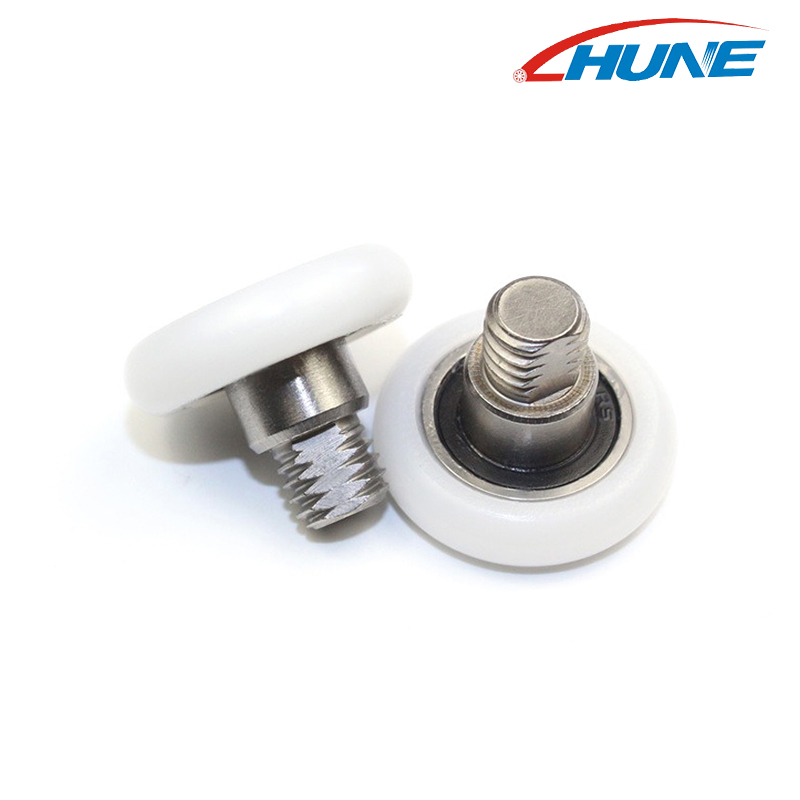






 English
English  Español
Español  日本語
日本語 